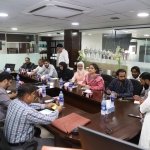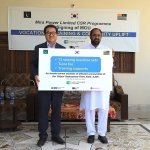102 MW Gulpur Hydropower Project is a unique project in the history of Pakistan considering its Technical as well as Environmental Importance. The Project has been developed within the boundaries of the Poonch River Mahseer National Park which was notified by the Government of AJK in 2010. The SEA (Strategic Environmental Assessment) of rivers and tributaries of AJK classifies the Pooch River into the most critical category. A total of 37 fish species are associated with the Poonch River. Of these six fish species are listed in IUCN Red List with their status as:
- Kashmir Catfish (Glyptothorax kashmirensis) – Critically Endangered,
- Golden Mahseer (Tor putitora) – Endangered,
- Pabdah Catfish (Ompok pabda) – Near Threatened,
- Butter Catfish (Ompok bimaculatus) – Near Threatened,
- Common Carp (Cyprinus carpio) – Vulnerable,
- Twin-banded Loach (Botia rostrata) – Vulnerable
Considering requirements of the international financiers and local regulatory requirements, it was not an easy task to develop a hydropower scheme in a declared National Park for which no set example was available. However, to make the project viable, joint efforts were made by all the stakeholders. To further proceed on the project, the following commitments were initially made by the MPL;
- All required steps shall be taken for the betterment of the National Park
- Net Environmental Gain shall be ensured
To meet the commitments and get the required approvals for the execution of project, MPL executed extensive studies and complied with the stringent requirements which were not common for other hydropower projects.
With the support of project Lenders, MPL engaged well reputed and experienced consultants for the various studies and produced the following reports; Critical Habitat Analysis Report
- Rapid Cumulative Impact Assessment Report
- Draft Scoping Report for DRIFT and BAP
- Draft Biodiversity Impact Assessment Report
- Biodiversity Action Plan
As a result of the studies, MPL anticipated that more resettlement is required and the likelihood of achieving a net environmental gain with the original design having 6 kilometres of low flow/dry section with peaking scenarios will be difficult. Therefore, design of the project is changed on the basis of the environmental and social matters and the studies were repeated accordingly. Layout of change in design is shown below:
Based on the revised design, the fowling documents were submitted to the project Lenders and regulator;
- Ecological Flow Assessment- based on revised design option
- Detailed Socioeconomic Surveys
- ESIA Update and Integration
- Climate Change Risk Assessment
- Feasibility Assessment for Achieving Net Gain
- Biodiversity Monitoring and Evaluation Plan
- Proposed Ecological Flow Management Plan
- Mahaseer Hatchery Design and Restocking Program
- Proposed Road Map for National Park Management Plan
The BAP and ESIA were further updated upon completion of above studies and required an Environmental and Social Management System (ESMS) to implement all the approved plans.During the course of studies and approvals, MPL received an unprecedented support from the project Lenders, AJK Government, Regulator, District Administration, AJK Wildlife and Fisheries Department, Non-Governmental Organization other Civil Societies and Academic Institutions.
Upon completion of all the pre-requisites, a Conditional Environmental Approval (NOC) for the construction of the project was granted by the regulator (AJK EPA). Furthermore, 1st time in the history of Pakistan, a NOC was also granted by the AJK Wildlife and Fisheries Department for the execution of hydropower project.
During the entire construction phase, strict implementation of the Environmental and Social Management System (ESMS) were ensured under the supervision of project Lenders, regulator and 3rd party consultants. The Company has also signed an agreement with the AJK Wildlife and Fisheries Department for the Implementation of Biodiversity Action Plan (BAP). The same BAP was successfully implemented during the construction phase under the monitoring of state level committee and 3rd party Monitoring & Evaluation Consultant.
At the time of Commercial Operations Date (CoD), a compressive report was submitted to the AJK EPA for the issuance of Written Confirmation of Compliance (WCC) and Environmental Approval for the operational phase. Acknowledging the facts, AJK EPA as a regulator issued Conditional Environmental Approval (NOC) and WCC.
Currently, the plant is in operational phase and the Company is in compliance with regulatory and lender’s requirement through implementation of Environmental & Social Management System. The BAP is being implemented successfully under the public private partnership during the operational phase as well and achieving its desired results of Net Gain. A complete watch & Ward System is in place for the successful implementation of the BAP. Furthermore, a state level committee and a M&E Consultant is regularly monitoring the activities related to the BAP implementation. Financing for the implementation of the BAP is being provided by the Company and the same will continue during the entire operational phase.
Currently, the Company is conducting an Environmental Audit and revision of the Biodiversity Action Plan in close coordination with the project Lenders, AJK EPA, Wildlife & Fisheries Department and other stakeholders.






